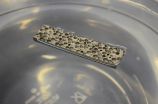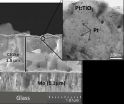(Press-News.org) Transgenic Huntington's disease monkeys show similarity to humans with Huntington's in their progressive neurodegeneration and decline of motor control, scientists from Yerkes National Primate Research Center, Emory University, report.
These findings are promising for developing a preclinical, large animal model of Huntington's disease for assessing new therapeutics, which could ultimately provide better treatment options, including altering the course of the disease.
In this first multiyear study on a transgenic nonhuman primate model for Huntington's, lead author Anthony Chan, DVM, PhD, engineered monkeys to develop a slower and more gradual form of the neurodegenerative disease. Chan says, "It was important to recapitulate progressive changes in clinical measurements, such as cognitive behaviors and neural anatomical changes as the Huntington's disease monkeys age. Our finding of similarity in clinical progression between human patients and Huntington's disease monkeys suggests monkeys could become a preclinical, large animal model for the development of new treatments." Chan is associate professor of human genetics at Emory University School of Medicine and a researcher at the Yerkes National Primate Research Center.
The findings are scheduled for online publication in PLOS ONE on May 12, 2015.
Although mouse models of Huntington's exist, it is difficult for researchers to study certain aspects of the disease. A nonhuman primate model could eliminate the current gap and allow researchers to better study aspects of fine motor control and cognition in a nervous system that is structurally similar to humans'.
Another potential, says Chan, is "the promise a nonhuman primate model holds for developing treatments that could alter the course of Huntington's disease. Right now, we can address the symptoms of the disease, but we want to do more. A nonhuman primate model should be able to help us better help others."
With support from the Yerkes Research Center and the Office of Research Infrastructure Programs at the National Institutes of Health, Chan and colleagues are establishing a Transgenic Huntington's Disease Monkey Resource to facilitate preclinical research, consisting of a breeding colony, a biomaterial repository and a sperm bank. This resource will be the first of its kind and will be a prototype for other transgenic primate research programs with rhesus monkeys and marmosets.
Huntington's is an inherited disease caused by a gene encoding a toxic protein (mutant huntingtin) that causes brain cells to die. Symptoms commonly appear in the 30s or 40s and include uncontrolled movements, balance problems, mood swings and cognitive decline. There is also a juvenile form of Huntington's disease, which can occur during the teenage years.
In the PLOS ONE paper, Chan and colleagues describe how three male rhesus macaques they studied displayed cognitive and motor impairments emerging at 16 months of age, and dystonia and signs of neurodegeneration on brain imaging at 24 months of age. Rhesus macaques normally go through puberty around 3-5 years of age and can live for 25 or 30 years. Studying these symptoms earlier in the animal model gives researchers more time to monitor the progression of the disease as well as assess the efficacy of potential therapeutics and to determine if and when the course of the disease could be altered.
These three monkeys carried a gene encoding a fragment of mutant human huntingtin. The researchers introduced this extra gene, designed to be regulated in a way that is similar to normal huntingtin genes, by injecting rhesus macaque oocytes with a viral vector.
Beginning at 8 months of age, the researchers tested the animals in an "object retrieval detour task" (retrieval of an M&M candy from a transparent box that is open on one side) and a fine motor task (freeing a Life Saver candy by moving it along a bent metal rod), both well-established tests for cognitive and fine motor control in nonhuman primates. The researchers also used viewed the monkeys' brains via magnetic resonance imaging (MRI), which revealed progressive degeneration of the striatum, a region of the brain known to be affected in humans with Huntington's.
INFORMATION:
Co-authors on the paper include Jocelyne Bachevalier, PhD, division chief of developmental and cognitive neuroscience at Yerkes, Xiaodong Zhang, PhD, assistant director of the Yerkes Imaging Center, and Xiaojiang Li, MD, PhD, Emory School of Medicine department of Human Genetics.
DURHAM, N.C. -- Lemur girls behave more like the guys, thanks to a little testosterone, according to a new study.
Males rule in most of the animal world. But when it comes to conventional gender roles, lemurs -- distant primate cousins of ours -- buck the trend.
It's not uncommon for lady lemurs to bite their mates, snatch a piece of fruit from their hands, whack them in the head or shove them out of prime sleeping spots. Females mark their territories with distinctive scents just as often as the males do. Males often don't take their share of a meal until the females ...
BROOKLYN, New York -- Researchers have demonstrated a new metal matrix composite that is so light that it can float on water. A boat made of such lightweight composites will not sink despite damage to its structure. The new material also promises to improve automotive fuel economy because it combines light weight with heat resistance.
Although syntactic foams have been around for many years, this is the first development of a lightweight metal matrix syntactic foam. It is the work of a team of researchers from Deep Springs Technology (DST) and the New York University ...
The sun was just beginning to rise as two men headed down to the beach to board a small inflatable boat. Searching for abalone was on their agenda for the day. Their excitement was difficult to contain as they surveyed the coastline looking for sand ridges -- an important clue that abalone may be near. The two men, David Witting and Bill Hagey, share a passion for finding the now rare white abalone and understanding the movement and feeding behaviors of all abalone species.
David Witting, a NOAA Fisheries biologist, has been engaged in efforts to restore abalone populations ...
Many of us are familiar with electrolytic splitting of water from their school days: if you hold two electrodes into an aqueous electrolyte and apply a sufficient voltage, gas bubbles of hydrogen and oxygen are formed. If this voltage is generated by sunlight in a solar cell, then you could store solar energy by generating hydrogen gas.This is because hydrogen is a versatile medium of storing and using "chemical energy". Research teams all over the world are therefore working hard to develop compact, robust, and cost-effective systems that can accomplish this challenge. ...
For the first time, a researcher at the University of Waterloo has theoretically demonstrated that it is possible to detect a single nuclear spin at room temperature, which could pave the way for new approaches to medical diagnostics.
Published in the journal Nature nanotechnology this week, Amir Yacoby from the University of Waterloo, along with colleagues from University of Basel and RWTH Aachen University, propose a theoretical scheme that could lead to enhanced Nuclear Magnetic Resonance (NMR) imaging of biological materials in the near future by using weak magnetic ...
TORONTO, ON -- "Cloudy for the morning, turning to clear with scorching heat in the afternoon."
While this might describe a typical late-summer day in many places on Earth, it may also apply to planets outside our solar system, according to a new study by an international team of astrophysicists from the University of Toronto, York University and Queen's University Belfast.
Using sensitive observations from the Kepler space telescope, the researchers have uncovered evidence of daily weather cycles on six extra-solar planets seen to exhibit different phases. Such phase ...
In a new study published in the Protein & Cell, Chen-Yu Zhang's group at Nanjing University reports that small non-coding RNAs in maternal food can transfer through placenta to regulate fetal gene expression.
MicroRNAs (miRNA) are a class of noncoding RNAs with lengths of approximately 22 nucleotides that bind to target messenger RNAs to inhibit protein translation. In previous studies, the same group has found that plant miRNAs can enter into the host blood and tissues via the route of food-intake. The food-derived exogenous miRNAs are absorbed, packaged into microvesical ...
WASHINGTON, DC -- May 12, 2015-- A multidisciplinary group of US-based researchers has shown that the mixture of species found within natural bacterial communities in the environment can accurately predict the presence of contaminants such as uranium, nitrate, and oil. The findings, published this week in mBio, the online open-access journal of the American Society for Microbiology, show that the rapid sequencing of microbiomes in place at environmental sites can be used to monitor damage caused by human activity.
"This approach might be a general way for us to see anthropogenic ...
Nerve cells that produce dopamine for the purpose of transmitting signals to other cells affect numerous crucial brain functions. This becomes evident in diseases such as Parkinson's and schizophrenia, where dopamine transmission in the brain is impaired. In collaboration with researchers from Bonn, RUB scientists at the Mercator Research Group "Structure of Memory" have now identified in what way a specific form of this important cell is generated and which networks it forms in the course of brain development. In the process, the researchers discovered a data highway of ...
Amsterdam, May 12, 2015 - Wearable E-skin that can measure heart rate and blood pressure, and paper diagnostic machines the size of a credit card that can give instant readings on blood and saliva samples are two new bio-sensing technologies presented at Elsevier's 4th International Conference on Bio-Sensing Technology in Lisbon, Portugal on 12 May 2015.
Bio-sensors can detect and analyze data to give patients information on their heart rate and blood pressure, blood sugar and hormone levels, and even test whether they are infected with antibiotic-resistant bacteria. ...



